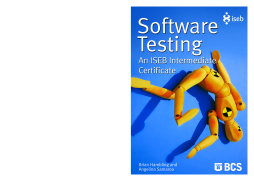
Additional Information
Book Details
Abstract
Covering testing fundamentals, reviews, testing and risk, test management and test analysis, this book helps newly qualified software testers to learn the skills and techniques to take them to the next level. Written by leading authors in the field, the book includes worked examples and sample questions, and is the only official textbook of the ISEB Intermediate Certificate in Software Testing.
Brian Hambling has experienced software development from a developer's, project manager's and quality manager's perspective in a career spanning over 30 years. Angelina Samaroo CEng is an instructor for the ISEB Foundation and Intermediate Courses in Software Testing. The authors are both experienced ISEB examination setters and markers.
Covering testing fundamentals, reviews, testing and risk, test management and test analysis, this book helps newly qualified software testers to learn the skills and techniques to take them to the next level. Written by leading authors in the field, the book includes worked examples and sample questions and is the only official textbook of the ISEB Intermediate Certificate in Software Testing. It is structured to support learning of the key ideas in the syllabus quickly and efficiently for those who do not plan to attend a course, and to support structured revision for anyone preparing for the exam, whether or not they have attended a training course.
Table of Contents
| Section Title | Page | Action | Price |
|---|---|---|---|
| Cover | Cover | ||
| Copyright | iv | ||
| Software Testing | i | ||
| The British Computer Society | ii | ||
| Software Testing | iii | ||
| Contents | v | ||
| Figures and tables | vii | ||
| Authors | ix | ||
| Acknowledgements | xi | ||
| Preface | xii | ||
| Introduction | 1 | ||
| ISEB Software Testing certificates | 1 | ||
| The Software Testing Intermediate Certificate | 2 | ||
| The Intermediate Certificate syllabus | 2 | ||
| The Intermediate Certificate examination | 5 | ||
| Relationship of the book to the syllabus | 5 | ||
| How to get the best out of this book | 6 | ||
| 1 Testing fundamentals | 8 | ||
| Background | 8 | ||
| Introduction to testing fundamentals | 8 | ||
| Relevant Foundation topics | 10 | ||
| Application domains | 11 | ||
| Software development models, test levels and test types | 21 | ||
| Testing, maintenance and change | 30 | ||
| The Fundamental Test Process | 32 | ||
| Scenario analysis | 34 | ||
| Summary | 36 | ||
| Example examination questions | 36 | ||
| 2 Reviews | 44 | ||
| Background | 44 | ||
| Introduction to reviews | 44 | ||
| Principles of reviews | 46 | ||
| Types of review | 48 | ||
| Performing successful reviews | 54 | ||
| Summary | 58 | ||
| Example examination questions | 59 | ||
| 3 Testing and risk | 66 | ||
| Background | 66 | ||
| Introduction to testing and risk | 66 | ||
| Risk fundamentals | 68 | ||
| Risk management | 73 | ||
| Risk-based testing | 79 | ||
| Summary | 80 | ||
| Example examination questions | 81 | ||
| 4 Test management | 86 | ||
| Background | 86 | ||
| Introduction to test management | 86 | ||
| Test policy, test strategy, test plans | 88 | ||
| Entry and exit criteria | 95 | ||
| Estimating techniques | 99 | ||
| Test monitoring | 103 | ||
| Incident management | 108 | ||
| Summary | 111 | ||
| Example examination questions | 112 | ||
| 5 Test analysis and design | 119 | ||
| Background | 119 | ||
| Introduction to test analysis and design | 119 | ||
| Approaches to testing | 121 | ||
| Fundamentals of test analysis and test design | 122 | ||
| Test design techniques and test types | 127 | ||
| Test coverage | 135 | ||
| Scenario analysis | 138 | ||
| Summary | 140 | ||
| Example examination questions | 141 | ||
| 6 The examination | 146 | ||
| Introduction | 146 | ||
| The Intermediate Certificate examination | 146 | ||
| Scenario analysis | 150 | ||
| Planning examination revision | 151 | ||
| Taking the examination | 153 | ||
| Summary | 153 | ||
| Appendix A: Mind maps of the main chapters | 155 | ||
| Appendix B: Definition, interpretation and examples of K levels | 160 | ||
| Index | 163 | ||
| Back Cover | 166 |
